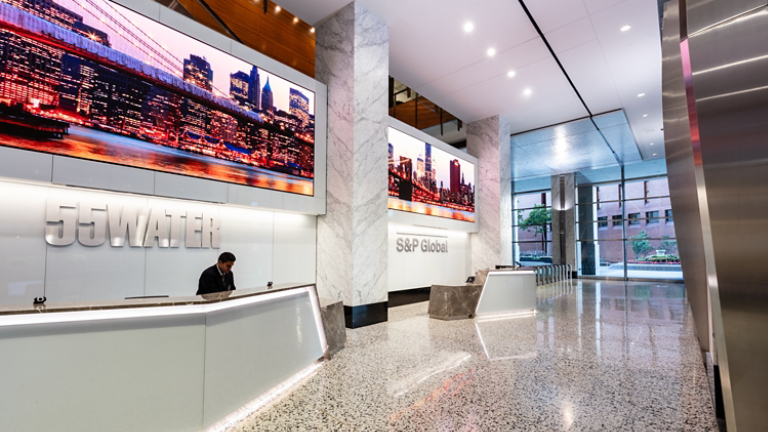Quick Facts
- Location
- New York, New York
- Industry
- Commercial Real Estate
- Products
- Chillers • Energy Storage • Heat Pumps
- Topics
- Efficiency • Optimal Comfort
Results
- $1.2M annual avoidance of NYC Local Law 97 fines
- ~70% in steam savings
- ~20% reduction in energy use intensity (EUI)
- $14.5M secured in IRA tax credits and utility rebates

Highlights
- First electrification retrofit using this technology in a NYC building of this size, spanning 3.8M square feet.
- Recognized as a model for electrification and decarbonization in NYC.
- Completed in 12 months to ensure that incentives and tax benefits were received.
- Integrated approach to compliance, decarbonization and resilience.
- Improved flexibility to adapt to changing tenant requirements.
- Multiple systems provide redundancy, reducing risk of downtime.
The Challenge
Spanning 3.8 million square feet, claiming its own zip code, and housing 86 elevators, 55 Water Street stands as the largest office building in NYC and the nation's second largest privately-owned office building in the United States1. Purchased by the Retirement Systems of Alabama (RSA) in 1993 for about $202 million, the building’s value now exceeds $1.5 billion under New Water Street Corporation’s management.
With high-profile tenants including S&P Global and the NYC Department of Transportation, New Water Street Corporation has always prioritized their needs. This includes investing in building upgrades, although that’s not always easy. Most buildings in NYC rely on steam systems for heat, which are notorious for poor performance and high utility bills2. Coupled with aging infrastructure and the looming threat of NYC Local Law 97 (LL97),3 55 Water Street building management was facing mounting pressure. They needed a holistic solution that would resolve the issues and keep tenants undisturbed.
The Solution
Trane had been collaborating with 55 Water Street for more than a decade, supporting a range of infrastructure and energy upgrades. That long-standing relationship provided a deep understanding of the building’s systems and operations, which was critical as the team prepared to take on its most ambitious project yet.
“I have a lot of trust with Trane,” said Dan Palino, Chief Operating Officer, 55 Water Street. “It was a big commitment to get a project of this size completed in a year with no disruption to tenants, but I was confident in their ability to get it done.”
With that trust as the foundation, Trane joined an experienced team consisting of JB&B, the engineering consultant, and Fischer Energy, the owner’s representative. Together they designed and delivered a comprehensive solution built for performance, reliability, and efficiency.
A Fully Electrified System
The project involved a complete replacement of legacy HVAC equipment. Two centrifugal chillers and 27 modular chillers were installed, along with a heat recovery system built around a water-source heat pump. This cooling system upgrade utilizes thermal energy storage to capture and repurpose heat that would have otherwise been wasted as part of the cooling process. The configuration also allowed for greater heating and cooling flexibility to meet varying load conditions and improved redundancy by spreading capacity across multiple systems, rather than relying on a few large machines.
Putting Tenants First
Because the building remained fully occupied for the duration of the project, maintaining tenant comfort and business continuity was essential. Approximately two thirds of construction took place at night to help reduce disruption, and with the mechanical room located on the 14th floor, every phase required detailed planning and constant coordination.
“Trane pre-coordinated many aspects of the project early on in the process," said Scott Lewin, North America Energy Services Operations Leader at Trane. "By doing this early we were able to put an execution plan into place that considered the logistics of an occupied, dynamic facility such as 55 Water Street. This helped eliminate delays and conflicts later in the installation process. By taking on the responsibility, ownership, and accountability, we were able to complete this project within a year. It’s not easy when you consider that we started the demo before the design was 100% complete.”
Sustaining Building Performance
To promote smooth operations, Trane provided hands-on training for the building’s engineering team. Staff were equipped to manage the system with confidence, supporting ongoing, reliable performance from day one.
The Results
Initially, the upgrades at 55 Water Street focused on avoiding NYC Local Law 97 penalties and reducing operating costs. With the building fully occupied and the timeline fixed, the stakes were high. Ultimately, the project team persevered and delivered an electrification transformation that improved performance, increased flexibility, and positioned the building for long term resilience and regulatory success.
“The project was installed by Trane in a one-year time frame,” said Palino. “They had to commit to that because of the rebate, and they delivered. I was very impressed.”
With the project completed on time, 55 Water Street was able to avoid $1.2 million in annual fines under NYC Local Law 97, in addition to unlocking approximately $5.5 million in utility rebates and $9 million in Inflation Reduction Act (IRA) tax credits.
The tailored solution also reduced steam usage by approximately 70% and lowered overall energy intensity by nearly 20%, significantly cutting emissions and improving system flexibility to better serve tenant needs.
Today, building owners across New York City look to 55 Water Street as a model for electrification and decarbonization, proving that ambitious goals can be met even in the most complex and challenging scenarios.
1. https://www.55water.com/ownership/
2. https://be-exchange.org/case_study/steam-innovations-for-new-york-city-buildings/
3. https://www.nyc.gov/site/buildings/codes/ll97-greenhouse-gas-emissions-reductions.page
